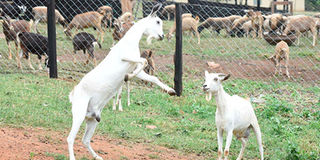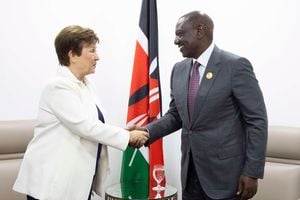The ‘kangaroo’ kid: A rare condition in young ones of goats

Goats at Chebororwa Agricultural Training Centre in Uasin Gishu County on October 16. Tendon contraction may affect the four limbs and render a kid unable to walk.
Vet on Call,
My colleague, Dr Chep, was amazed by the spectre of a kid standing on its hind legs and hopping around like a kangaroo.
The forelegs were permanently recoiled close to the chest and the hind ones were too big for the young goat’s size and age. The animal was about two months old.
Chep was excited to see the abnormal birth defect for the first time.
It is contradictory that doctors get excited by seeing abnormal situations when everyone expects them to be happy with the normal.
Our position, however, is that we are trained for the bad and the good. We only diagnose but never create the conditions.
The excitement comes from the confirmation that the doctor has been able to diagnose a condition she only read in books.
Jane, the animals’ caretaker, said the farm was excited for having the only “kangaroo” in the country.
The kid’s coat was foan, making it look more like a kangaroo.
The other three kids in the goat flock were normal and had been sired by the same buck.
Jane said they had never seen such an occurrence in the five years of keeping goats.
We had been called to the farm to investigate sudden illness and death of two adult goats and treat all the others because they were sickly.
In a last article, I narrated the experience with the goats. They all recovered after treatment.
The “kangaroo” kid had been born with the defect of the fore limbs and there was no way of treating the condition.
Defects offsprings are born with are called congenital abnormalities.
Some congenital problems can be corrected while others are permanent. Farmers and other animal keepers are advised not to breed animals with congenital defects to prevent multiplication of the genes that cause the defects in the population.
After treating the sick goats, we examined the “kangaroo” kid to understand the changes that had occurred in the structure of the front legs.
We found that the upper arm muscles and tendons had normal development but were losing volume and strength since they were not in normal use.
This is medically called under-use atrophy. When organs stay idle for long periods, the body redistributes the nutrient resources meant for the organs to other more active organs, resulting in shrinkage of the under-used ones.
The legs were twisted and greatly shrunken from the elbow down to the hoof.
There was poor development and shrinking of the muscles and ligaments from the elbow downwards.
The shrinking made the front legs assume a praying mantis position.
The increase of the size seen in the hind legs is a phenomenon called over-use hypertrophy.
Excessive use of organs for a long time causes the body to channel more resources to the affected organ and leading to its excessive growth.
I recall when bringing up our two sons who were born close together, I ended up carrying both on my hands at the same time when we got our third child.
I always carried the older one on my right hand because he was heavier than the brother.
One day, I test-fitted a slim-fit shirt and the right sleeve could not accommodate my right hand.
It had undergone over-use hypertrophy due to carrying a heavier weight than the left one. It took long to equalise the circumference of the two hands.
I corrected the size of my right hand by shifting to carry the heavier child on the left.
We concluded the kangaroo kid would spend its life hopping around and walking on the elbows when down on all four legs.
We advised the kid should be slaughtered once it had packed up enough meat at about six months.
Jane’s kid had a condition called congenital tendon contracture. It occurs sporadically in newborn goats of all breeds worldwide. The cause of the problem is poorly understood.
However, animal scientists agree one cause of the problem is defective genes transmitted by bucks.
The genes only express themselves as contracted tendons if both parents have them. Carrier males and females with only one of the defective genes look normal.
It, therefore, means that if a buck fathers a kid with contracted tendons, the buck should be culled to prevent spread of the defective gene.
Fortunately, Jane’s buck had already been slaughtered after the last breeding season due to its advanced age.
The mother needs not be culled because females do not transmit the gene.
If Jane’s kid had been reported soon after birth, we could have attempted correction by forcing the elbows to open and fixing the legs with splints to keep them straight.
The technique has corrected the contracture in some kids but most do not recover.
In some cases, tendon contracture may affect the four limbs and render the kid unable to stand. Such kids are culled at an early age.
In other cases, the contracture may only affect segments of one or more limbs. Animals with mild contracture may be reared for meat but must not be bred.





